Kealakekua Bay (pronounce each vowel), is about 20 miles south of Kona on the Big Island, and is believed to be the place where Captain James Cook arrived in 1778. He was searching for a northwest passage to England and stopped in Hawai’i, seeking shelter from the winter months. I can tell you from experience that Hawai’i in the winter has a much nicer climate than England in the summer!
Yesterday, our excursion took us to four of the five volcanoes that formed Hawai’i; today, we were on the fifth one. We were able to see vog–volcanic smog. It makes sense if you think about it: the active volcanoes on Hawai’i are always spewing smoke that contains ash so, logically, there are a lot of ash particles in the air, making the mountaintops look hazy. Kona is most famous for its coffee. It has the perfect climate to produce eight million pounds of coffee per year.
Hawai’i’s beaches have a variety of sand colors, including white, black, and green. I liked the black sand beach on Maui, and wanted to see a rare green sand beach, but it wasn’t on our excursion itinerary. Green sand beaches exist only on Hawai’i and in the Galapagos Islands, Guam, and Norway. Ted and I will have to see a green sand beach on our next trip to the islands. In the Hawaiian Islands, nearly all the shoreline is public. Isn’t that a great idea? I hate that, on the U.S. mainland, hotels, resorts, and beachfront property owners can claim beaches as their private property!
Kona means “leeward side” in Hawaiian, meaning it’s on the west side of the island. (Remember the easterly trades.) While Volcanoes National Park on the east side of the island gets over 100 inches of rain/year, Kona gets fewer than 10 inches. Although Hawai’i is more than twice the size of all the other Hawaiian Islands combined, it is the least populated island per square mile. Most people on Hawai’i live in Hilo and along the Kona coast (properly called the Kohala-Kona coast because Kona is technically a district, not a city). Kona’s harbor was too small and shallow for our ship, so we had to dock offshore and take a tender to the city.
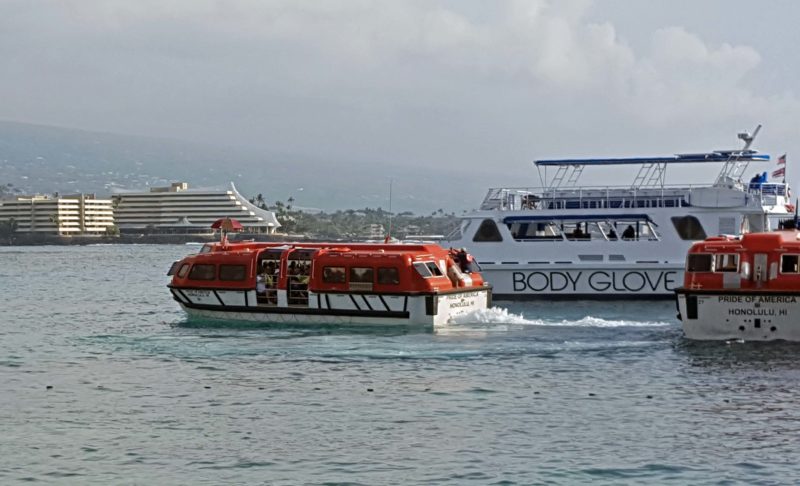
The tender was launched from our ship. As a tender (aka shuttle), it can carry 97 people; as a lifeboat, it can carry 150 people. It is stocked with food and survival items, and feels a lot safer and more comfortable than the lifeboats in the “Titanic” movie.
Anyone with some knowledge of Hawai’i has heard of King Kamehameha. Kamehameha was born as Halley’s Comet passed over. The comet was interpreted as a sign that a boy child of great power would be born and that he would be a “slayer of chiefs.” To protect him from assassination by other less powerful chiefs, Kamehameha was sent as a child to live in isolation with his aunt and uncle on another island. Meha means “lonely.” The Hawaiian language repeats words for emphasis, so Kamehameha means “very lonely”–a description of his childhood. Kamehameha was an imposing person. His actual shoe size is known and, from that, he is estimated to have been at least seven feet tall.
Like all young Hawaiian men of his time, Kamehameha trained to become a warrior. He witnessed Captain Cook being clubbed to death and saw the British Brown Bess muskets in action. He decided to master the use of the British modern weaponry, unite the islands, and prevent any other foreign power from conquering them in the future. He was the first chief/king to unite the islands, each of which previously had its own chief and government, but it was not a peaceful unification–he defeated the other chiefs in battles, beginning with his cousin who was also a chief.
We had a wonderful excursion today to the Secret Falls of Kohala. (Of course, if there are excursions to the falls, they are no longer a secret.) It was over an hour’s drive to the trailhead, so we had a chance to see some of the evolving landscape of Hawai’i. It reminded Ted and me of Iceland–another “new” landscape that is visibly evolving.
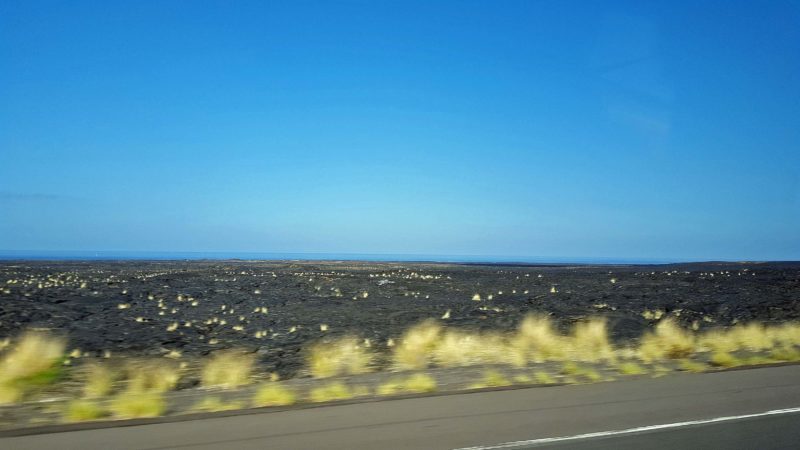
This is an area that has been “recently” covered by fresh lava, so it is nearly completely barren.
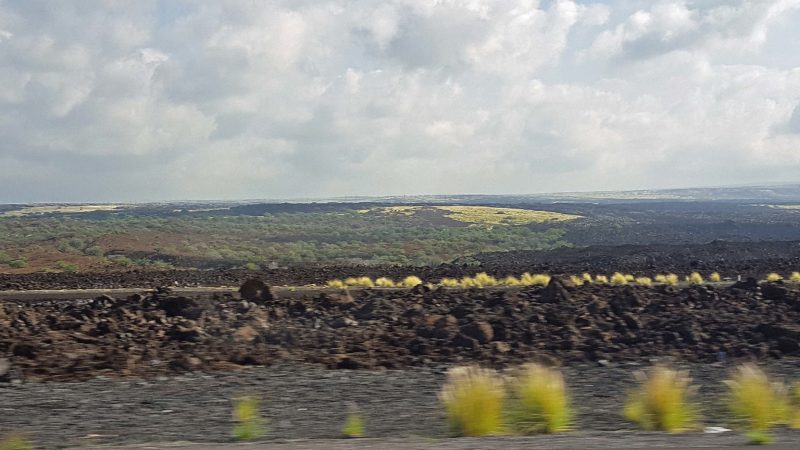
This lava surface is older. Grasses and plants are becoming more prolific.
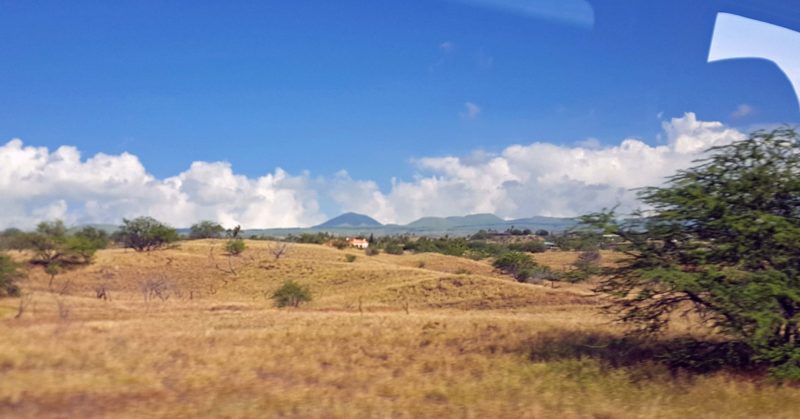
This is an “old” part of Hawai’i and has real soil that can support trees and shrubs.
The first part of our ride to the trailhead was on paved roads in a nice, 15-passenger van (there were only 12 people in our group, plus the guide). The first hint of change was when we parked at a rest stop and the guide handed out backpacks, water, trekking poles, and sunscreen. (Ted and I already had all of those things–except the trekking poles–with us, and so did a few of the other people.) Then he directed us to a 6-wheel drive vehicle that we’d need for the off-road part of the drive.
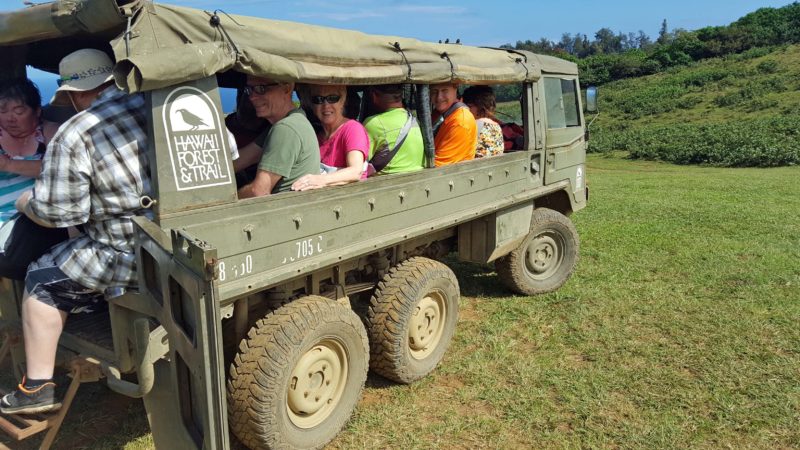
My first ride in an OTR vehicle.

Here’s our cozy group, ready for adventure.
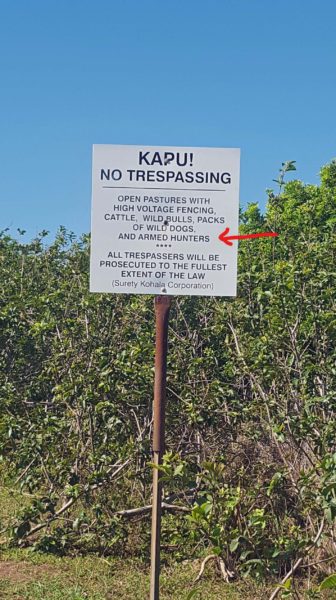
There were dangers as we drove first on a gravel path, then on mud tracks, and then across open land, including pastures.
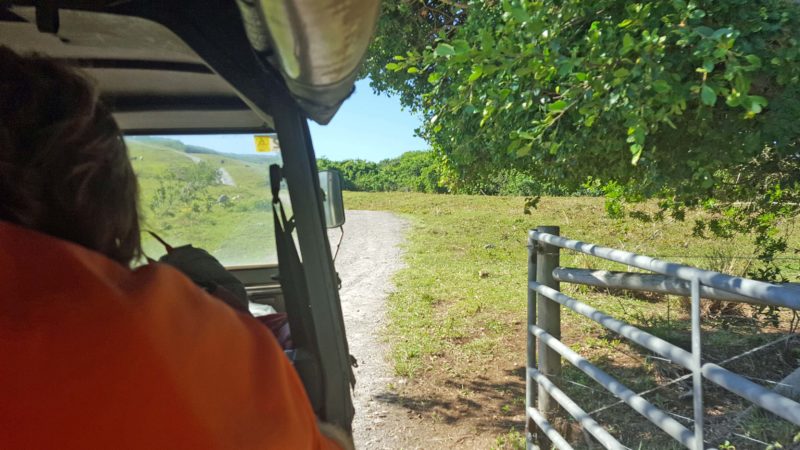
Part of the gravel path. The driver had to get out to open and close some gates along the way.
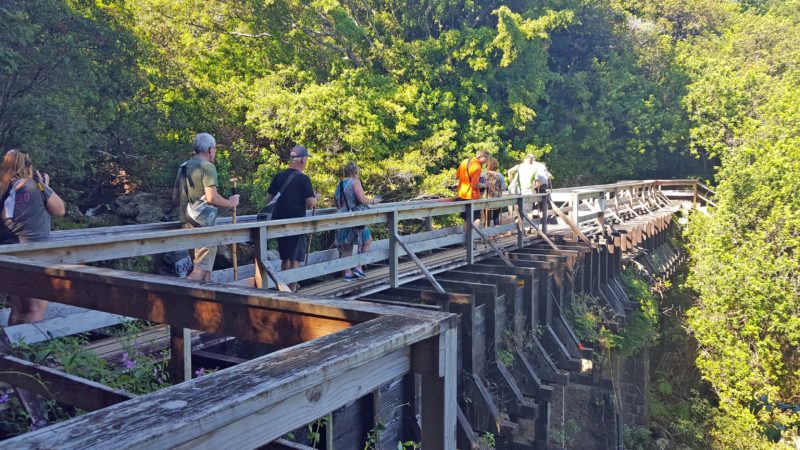
The hike included this bridge over a part of Alexander and Baldwin’s aqueduct.
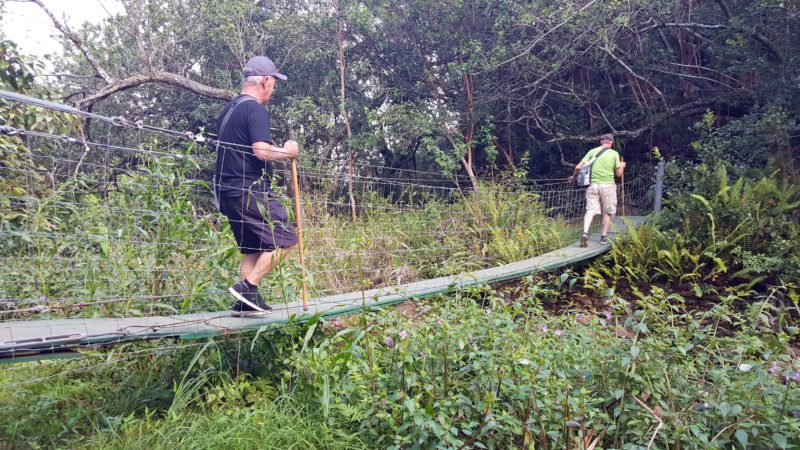
Later on, there was a narrow suspension bridge.
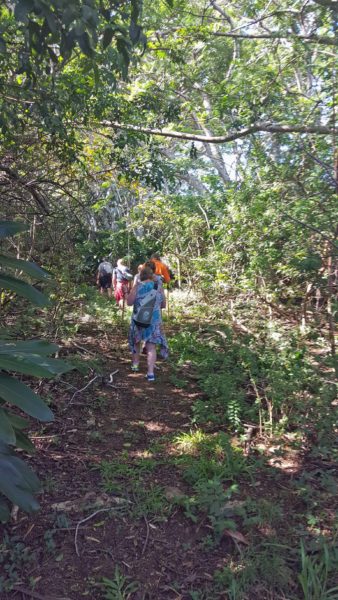
This is a level part of the trail we hiked. The forest became denser and the trail became steeper as we worked our way upward to the Secret Falls of Kohana.
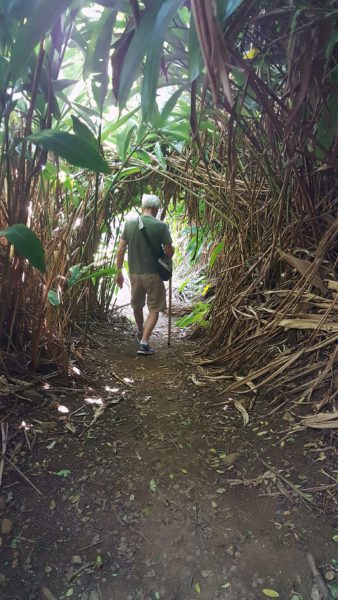
You can see that this area of the trail would become overgrown rapidly if it weren’t cut back regularly for hiking groups.
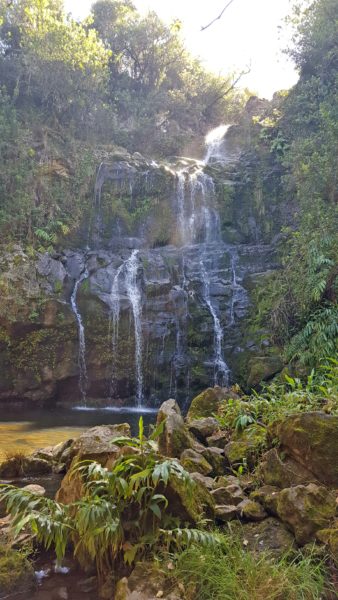
Here are the Secret Falls. There were several waterfalls along the trail, but this one was my favorite. It is also called Ohana Falls. “Ohana” means family. The falls begin as one, then branch into many–like children and grandchildren. At the bottom, all the members re-unite in a single stream, and the family cycle is repeated.

The next waterfall included a nice pool for swimming. About half of our group got in the water, but I abstained. I wasn’t eager to swim in water colder than 65 degrees. I’ll do it if Ted and I come back in the summer.

Our reward for the hike was a hilltop picnic.
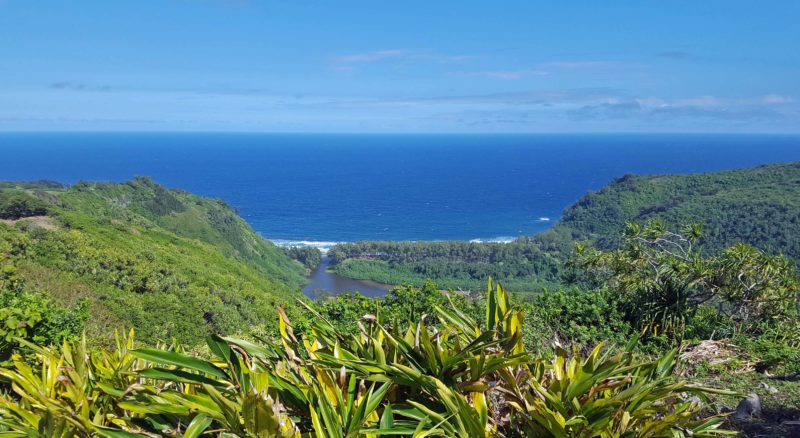
It’s hard to imagine a better lunchtime view. In the movie “The Descendants,” this is the pristine piece of land the family considered selling.
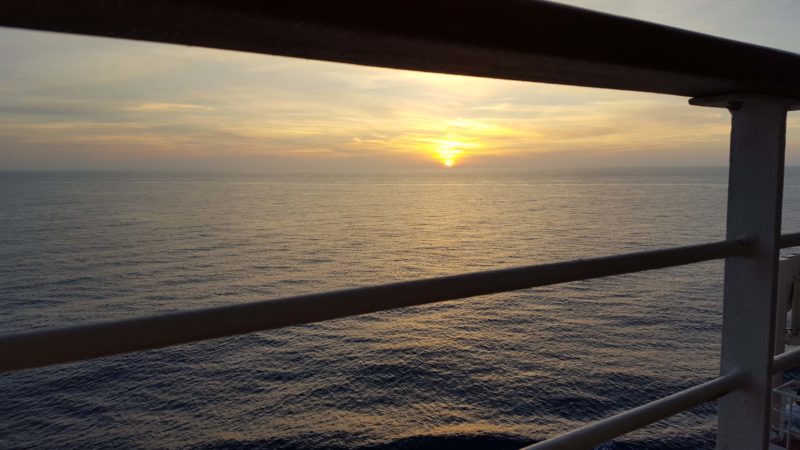
When we returned to the ship after a wonderful day outdoors, Ted and I enjoyed the sunset over the Pacific from our stateroom balcony.